Affiliate marketing is a million-dollar industry that is growing every day and is offering opportunities to individuals who are looking to make money online. Affiliate Marketing is a kind of digital marketing in which companies connect with third parties to promote their service and products. These third parties are called the Affiliates who get compensation for the leads, sales, or traffic they bring for the company depending upon the type. The process is quite easy like running ads, just posting the link, or emailing the clients.
Let’s look at some of the popular Affiliate marketing Examples: Amazon was one the pioneers of affiliate marketing, being the first to start the concept of marketing someone else’s product to get compensation in return. Etsy, eBay, Buzzfeed, etc are some of the other well-known examples of affiliate marketing.
Best Affiliate Marketing Programs to Join
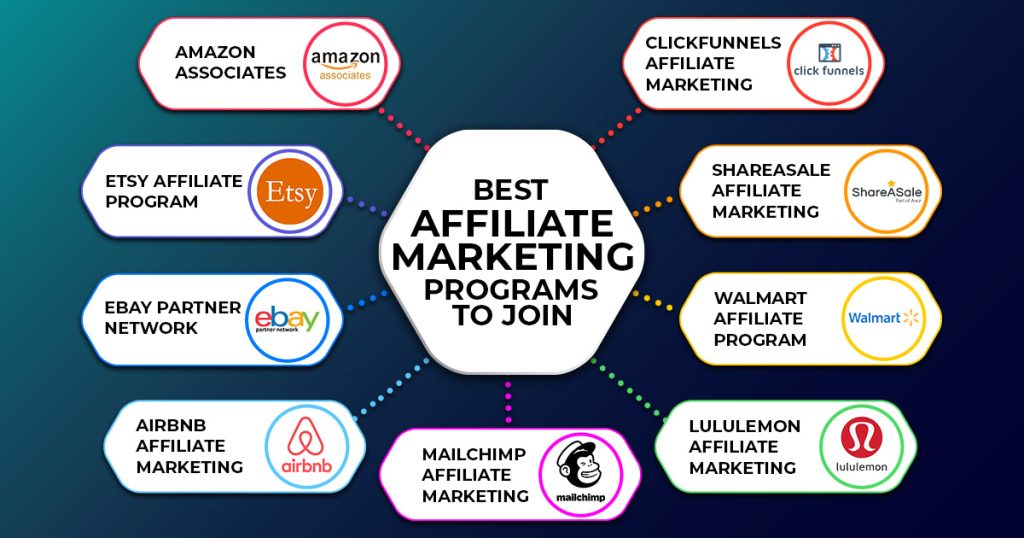
1. Amazon Associates:
Creators, bloggers, and websites display Amazon products and earn commissions on purchases generated through their links. Sites must meet strict criteria for content and avoid offensive material.
2. Etsy Affiliate Program:
Promote unique Etsy items via your website and earn commissions on resulting sales. Apply with an active website and a strong brand identity to qualify.
3. eBay Partner Network:
Share eBay listings or other sellers’ items from your site and earn commissions on purchases made within 24 hours of clicking your link. Commission rates vary by category and exclude promotions.
4. Airbnb Affiliate Marketing
As of 2021, Airbnb had over 400,000 active affiliates globally. They often use unattached strategies, such as blog posts, social media campaigns, or PPC advertising to drive traffic.
5. ClickFunnels Affiliate Marketing
ClickFunnels’ affiliate marketing program caters to individuals in the digital marketing and entrepreneurship niche. Affiliates often create content related to sales funnels, online marketing, and business growth.
6. ShareASale Affiliate Marketing
ShareASale manages over 15,000 affiliate programs and has facilitated millions of transactions since its inception. Affiliates on ShareASale collectively earned over $1 billion in commissions.
7. Walmart Affiliate Program
Walmart’s affiliate program often attracts affiliates in the retail and lifestyle niche. Affiliates may create content around product reviews, shopping hauls, or lifestyle recommendations, making their promotions closely related to Walmart’s product offerings.
8. Lululemon Affiliate Marketing
Lululemon’s affiliate program is known for offering exclusive perks, such as early access to product launches and special discounts, fostering strong relationships with affiliates. It invites influencers and fitness enthusiasts to take an involved approach.
9. Mailchimp Affiliate Marketing
Mailchimp’s affiliate program caters to individuals in the email marketing and business software niche. Affiliates often create content around email marketing strategies, automation, and business growth, making their promotions highly related to Mailchimp’s services.
How Do Affiliates Get Paid?
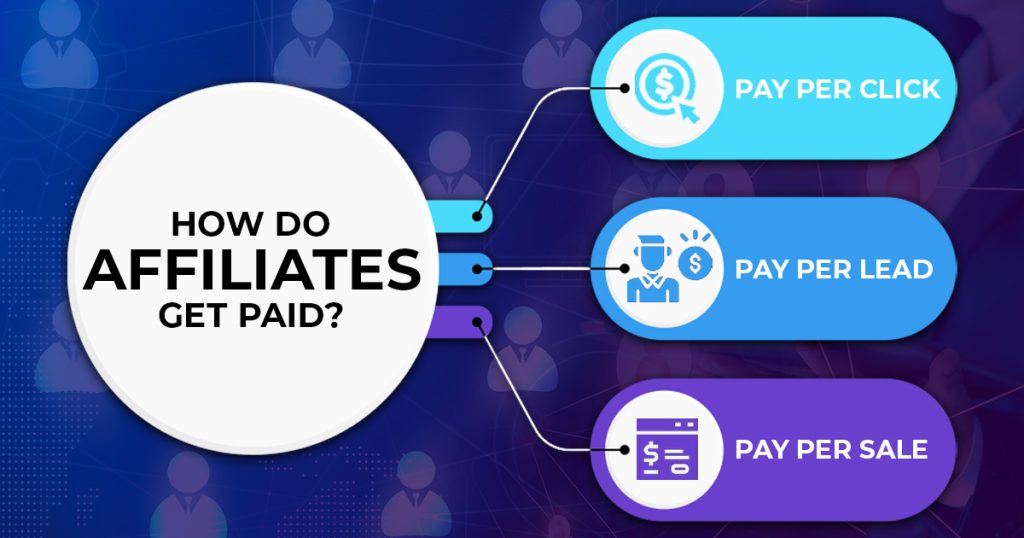
As mentioned earlier, the affiliates get paid when they sell, drive traffic, or bring leads to the company. But how do affiliates get paid? It’s simple affiliates get a link that can help companies track their performance and according to which they are paid. There are three types of payment models in affiliate marketing
- Pay Per Click (PPC): In this model, the affiliates get every time someone clicks on an ad or banner run by the affiliate.
- Pay Per Lead (PPL): In this affiliate payment model, the commission is given on each generated lead action, this may be signing up for newsletters, survey forms, or registering for an event or webinar.
- Pay Per Sale (PPS): In this affiliate payment model, the commission is given on each sale that happens through the affiliate link.
Types of Affiliate Marketing
In 2021, global spending on affiliate marketing was estimated to be around $12 billion. The affiliate marketing industry has been growing exponentially, with a CAGR of around 10% that will be $20 billion by 2024.
Affiliate Marketing had not been divided into categories for a long time but in 2009, Pat Flynn, a well-known affiliate marketer categorized it into three kinds namely unattached, related, and involved. People tend to trust more first-hand services and less those who are in chain marketing.
Let’s look at each of them with an example
1. Unattached Affiliate Marketing
Unattached affiliate marketing is the simplest form, where affiliates promote products without necessarily having a direct connection to their own content or niche. This type is often transaction-focused, and affiliates rely on strategies like pay-per-click (PPC) advertising or social media promotion to drive traffic.
Example: Amazon Associates
One of the most well-known examples of unattached affiliate marketing is Amazon Associates. Affiliates can promote an array of products available on Amazon. When users make purchases through these links, affiliates earn a commission, regardless of the content on their websites.
2. Related Affiliate Marketing
Related affiliate marketing is about promoting products or services that are closely aligned with the affiliate’s own content or niche. Affiliates choose products that complement their existing offerings, making the promotion feel more organic and relevant to their audience.
Example: Fitness Blogger and Athletic Clothing
Imagine a fitness blogger who regularly shares workout routines and health tips. If this blogger partners with an athletic clothing brand, promoting their products like workout gear or sneakers, the affiliation feels natural to the audience, increasing the likelihood of conversions.
3. Involved Affiliate Marketing
In involved affiliate marketing, affiliates have a deeper engagement with the products or services they promote. This often includes personal experience, reviews, or detailed insights. Affiliates may even collaborate with companies for exclusive promotions or product launches.
Example: Tech Enthusiast and Software Reviews
A tech enthusiast with a YouTube channel might engage in involved affiliate marketing by creating in-depth reviews of software products. By sharing personal experiences and demonstrating the software’s features, the affiliate builds trust with their audience. Collaborations with software companies can lead to exclusive discounts for their viewers, creating added value.
Why Be an Affiliate Marketer?
Passive income:
You can break free from a 9-5 job and earn while you are not even in front of your computer. With little time and effort into a campaign or by crafting a compelling blog, you can generate a steady flow of passive income.
No customer support:
In affiliate marketing, you don’t have to directly deal with customer satisfaction as they can directly reach the seller. And this does not even affect your commission.
Flexibility and Work from home:
If you love your bed and want permanent work from home, staying free from travel hassles and expenses, then affiliate marketing is for you. you just need a system like a laptop or computer and you are good to start your affiliate business.
Cost-effective
If you dream of being your own boss but don’t have that hefty investment needed for most of the business then you must try out Affiliate marketing. Starting affiliate marketing is a low-cost and low-risk investment that starts paying out in no time.
Performance-based rewards
With a 9-5 job, you are limited to earning a limited amount every month but in affiliate marketing your income is a direct result of your performance. The more you put effort in, the more you earn.
Common Types of Affiliate Marketing Channels
Interestingly, not all affiliates advertise the products in the same way. Different types of affiliate marketing channels ensure that you can choose the way to earn that aligns with your expertise and interest.
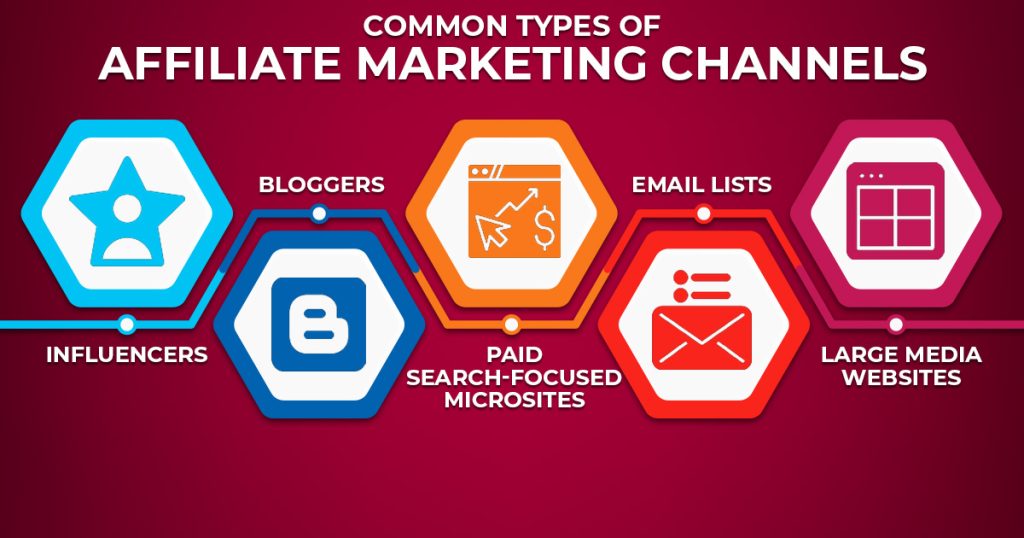
Influencers
With the increased reliability of user-generated content, the influencer market is growing and it is reported by experts that influencers who are creating content-sustainable products can earn an average monthly income of $555. If you have even 10k followers on social media, you can influence people to buy products and earn. Some of the most popular platforms are Instagram, Facebook, and TikTok.
Bloggers
64.48% of affiliate marketers leverage blogs as their primary traffic generation channel and an average affiliate marketing blogger earns between $30,000-and $50,000 per year, with the top ones making six-digit income. This is because this is the era of “Content is King” and blogs can rank organically without much effort if it is relevant.
Paid search-focused microsites
Paid search-focused microsites are known to attract highly targeted customers with specific buying intent. These are mini-websites that are only meant to drive traffic with the help of paid campaigns. Microsites offer targeted content, leading to conversion rates 2-3 times higher than traditional affiliate websites.
To start with a successful microsite affiliate marketing, you need to choose a specific product, do keyword research to bring out highly targeted keywords, create compelling and relevant content, optimize your landing page, and continuously track, analyze, and optimize it.
Email lists
Though it is one of the oldest methods of promoting a product, it is still an important way of affiliate marketing income. Email list affiliate marketing harnesses the power of email to nurture relationships and convert subscribers into paying customers. This strategy involves building an engaged email list and strategically promoting relevant affiliate products within your emails.
Around 80% of B2B companies use email marketing. For successful marketing through email, you need to create valuable giveaways such as ebooks, webinars, or discounts, focus on segmentation, and build personal relationships with customers through personalized content.
Large media websites
61% of consumers trust information from large media websites. Unlike micro websites, these websites are more focused on generating a massive audience by using banners and affiliate links. Amazon holds the largest share of affiliate networks that is 46.15%. It is the most renowned affiliate program known as affiliate associates. some of the well-known affiliate programs are:-
- AvantLink
- LinkConnector
- CJ Affiliate
- Affiliate Future
- ClickBank
- ShareASale
- FlexOffers
How to Start Affiliate Marketing
Starting affiliate marketing requires strategic planning and consistency. By following these steps, you can become successful affiliate marketing journey.
1. Choose Your Niche
Select a niche by analyzing your interests and expertise. Popular choices include health, technology, fashion, and personal finance.
2. Pick Your Affiliate Marketing Platforms and Method
Explore platforms like Amazon Associates, ClickBank, or ShareASale. Decide between unattached, related, or involved methods based on your content style.
3. Choose Your Channel
Opt for channels that suit your strengths: blogs, social media, YouTube, or email. Align the channel with your target audience and content format.
4. Find Your Product
Research and select products with a good commission structure, relevance to your niche, and positive reviews. Ensure the products resonate with your audience.
5. Create an Affiliate Program
For advanced users, consider creating your own program. Platforms like Refersion and Tapfiliate can help manage and track your affiliate marketing efforts.
6. Promote Your Affiliate Link
Leverage your chosen channels to promote links. Optimize blog content, create engaging social media posts, or craft compelling YouTube videos. Always disclose your affiliate relationships.
How to build a high-converting affiliate marketing funnel
An affiliate marketing funnel is a strategy designed to maximize the result like nurturing leads. A good funnel ensures that the conversion rate is high and customers and
These are four key stages in the buyer’s journey:
- Awareness- This stage is when the prospective customer becomes aware of the brand.
- Consideration- In this phase there, consider the product by analyzing its utility and USPs.
- Conversion- After considering they take action and become a customer
- Loyalty- Now as they are already customer, the business needs to hold them with benefits and customer support.
If you want to start with affiliate marketing you should first understand the user persona and make content that ensures to take prospective customers through these stages. First, you should give ample information for awareness then you should highlight the unique selling points and put a compelling call to action that leads to conversion.
Here are some of the benefits of a sales funnel:-
- Reach more prospects
- Boost your conversion rates
- Get repeat sales
- Increase brand trust and authority
- Command higher affiliate commissions
How to Build a Sales Funnel for Affiliate Marketing in 5 Easy Steps
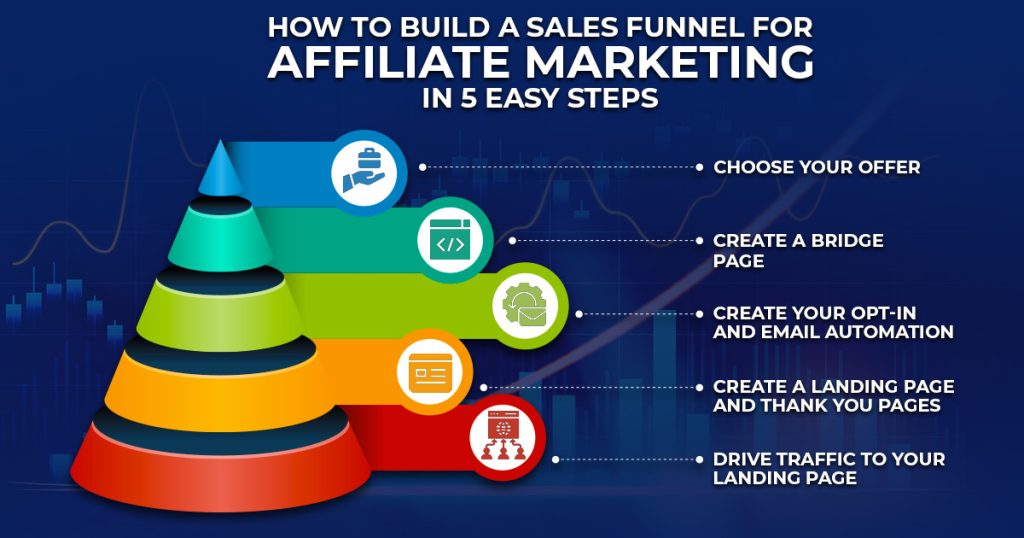
While you are starting an affiliate marketing journey, a well-crafted funnel can amplify your success. Let’s break it down into five simple steps.
1. Choose Your Offer
Offers, discounts, and giveaways are the best ways to attract people. Choose what offer you want to give to your customers.
2. Create a Bridge Page
Build a bridge page to smoothly transition your audience from your content to the affiliate offer. This page acts as a connector, providing valuable information about the product or service and setting the stage for conversion.
3. Create Your Opt-In and Email Automation
Compel your audience to share their email addresses through an opt-in form on your bridge page and build a mailing list. Set up email automation to nurture leads, share relevant content, and guide them towards the affiliate offer.
4. Create a Landing Page and Thank You Pages
Craft a compelling landing page focused on the affiliate offer. Highlight key benefits, and features, and include a clear call-to-action. After conversion, redirect users to a thank-you page expressing gratitude and providing additional value or offers.
5. Drive Traffic to Your Landing Page
Use various channels to drive traffic to your landing page. Utilize paid advertising, and share engaging and captivating content on social media platforms.
Affiliate Marketing Best Practices
By following Affiliate Marketing Best Practices, making money can be as easy as having fun! If you’re new to affiliate marketing, don’t worry –it’s not as complicated as it may seem. Follow the below-given steps to claim easy success in Affiliate Marketing:-
1) Make a plan
2) Set clear goals and objectives
3) Create customer persona
4) Choose the right affiliates
5) Put terms and conditions
6) Offer support to your affiliates
7) Create relevant and interesting content
8) Leverage cross-promotion
9) Keep up with trends
10) Make use of reporting tools to measure and analyze success
11) Mobile friendly optimisation
12) Keep it simple
13) Use humor
How to Create a Website for Affiliate Marketing
Fortunately, affiliate marketing is a sustainable revenue stream that anyone can start with just a laptop and a wifi. Build your website for affiliate marketing and partner with brands to earn as much as you want.
- Step 1: Choose a topic
First and foremost, you need to figure out your interest area and your expertise. It may be cooking exploring places or trying out new fashion and skin care products. Choose an interesting topic, identify your audience’s pain points, and post consistently.
- Step 2: Buy a domain name
Choose a domain name that is related to your niche. Make sure that your domain name is catchy and not too long. You can buy it from GoDaddy.com
- Step 3: Build your site
You can build your site on WordPress, Shopify, or Squarespace or even hire a freelancer web designer. After building your website you must optimise your website with the best SEO practices.
- Step 4: Get familiar with publishing
Now it’s time to learn publishing. But it is very easy as most of the content management systems are intuitive and it just takes a few minutes to post your content, and add links, photos, and videos.
- Step 5: Sign up for affiliate programs
After setting up your website right now you should find and sign up for affiliate programs Believe it or not, you’ve already reached the point where you can start signing up for affiliate programs.
- Step 6: Add affiliate links to your site
After you partner with a brand or successfully sign up for an affiliate program now search for products that you would like to promote. You’ll get an affiliate link that you can add to your site and when customers make purchases through it, you’ll get paid.
- Step 7: Drive traffic to your website
Now it’s time to bring customers to your site. You can do this by running ad campaigns or organically by using an effective SEO strategy.
- Step 8: Consistently publish high-quality content
Now consistency is the key and posting high-quality content regularly can bring success to your affiliate business.
9 Ways To Do Affiliate Marketing Without A Website
Now that we’ve got the theory out of the way, let’s look at nine practical tactics for affiliate marketing without a website.
- Posting On Online Forums & Communities
- Create YouTube Channel
- Use Paid Advertising On Search Engines
- Publish On Content Platforms
- Utilize Social Media
- Create Ebooks
- Take Advantage Of Email Marketing
- Record Podcasts
- Solo Ads- Solo ads are a type of email-based advertising that involves paying for access to someone else’s marketing list.
Affiliate Marketing Vs Dropshipping:
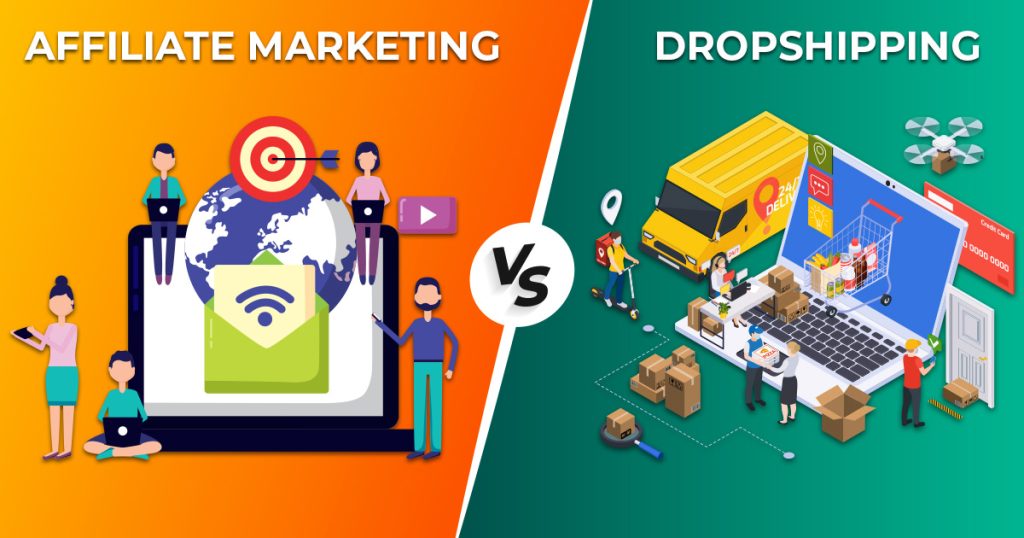
| Feature | Affiliate Marketing | Dropshipping |
| Role | Promote other companies’ products | Sell products under your brand name |
| Inventory | No inventory required | No inventory required (managed by supplier) |
| Profit Margin | Commission-based (typically lower) | Set your own prices (potentially higher) |
| Startup Costs | Low | Low to moderate |
| Marketing Focus | Attracting and converting potential buyers | Building brand identity and trust |
| Product Control | Limited | Full control over product selection and branding |
| Customer Service | Limited involvement | Responsible for handling customer inquiries and issues |
| Risks | Reliant on partner’s product quality and marketing | Reliant on supplier reliability and quality control |
| Scalability | Relatively easy to scale without additional investment | Requires more effort and investment to scale inventory and fulfillment |
| Examples | Bloggers promoting software, social media influencers recommending clothing | Online stores selling electronics, home goods, etc. |
Dropshipping is as good a business as affiliate marketing, but if you want to put less effort then you must start your affiliate marketing. As it is one of the easiest ways to earn money in 2024, no big investment is required, and no risk is involved, you just need the right knowledge to get started.

